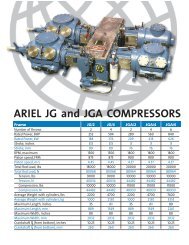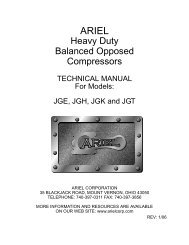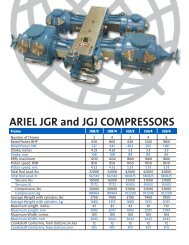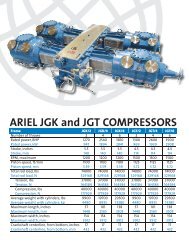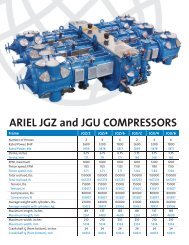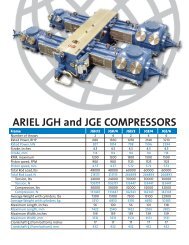Heavy Duty Balanced Opposed Compressors
Heavy Duty Balanced Opposed Compressors
Heavy Duty Balanced Opposed Compressors
Create successful ePaper yourself
Turn your PDF publications into a flip-book with our unique Google optimized e-Paper software.
FOR MODELS: JG AND JGA SECTION 4 - LUBRICATION AND VENTING<br />
1. Start up the compressor and bring up to normal operating pressure. After the<br />
operating pressures have stabilized, with all balance valves backed off (zero<br />
spring load), note the highest gauge pressure reached in a complete block<br />
cycle.<br />
2 Slowly increase the spring load on one balance valve, being careful to not<br />
exceed rupture disc rated pressure. Watch the gauge and if the maximum pressure<br />
increases, reduce the spring load until the highest pressure falls to the<br />
pressure noted in step 1, above. Tighten the lock nut against the cap, hand<br />
wrench tight.<br />
3 Repeat step 2, for the remaining valve(s).<br />
Maintain the system by recording the pressures and cycle times of the lubrication system at<br />
least once a day.<br />
Checking/Adjusting Balance Valves on Subsequent Start-up<br />
Ensure that all fittings are tight and any known leaks have been fixed. Purge the force feed<br />
system.<br />
Start the compressor and bring up to normal operating pressure. After the operating pressures<br />
have stabilized, check the pressure gauges to ensure the system is still balanced. If<br />
one or more line pressures are out of balance, wait for 2 to 3 hours to see if they become<br />
balanced. DO NOT adjust the balancing valves immediately. It is possible that some lube<br />
points will increase in injection pressure after a short period of run time and the system will<br />
become balanced if it is not balanced on start up.<br />
If a balance valve(s) was installed, but is not required, leave (or set) the spring adjustment at<br />
zero. If back-pressure on an unused balance valve is high enough, it may eventually begin<br />
to leak oil. In this case, replace the balance valve internal assembly with a plug assembly,<br />
Ariel Part Number A-10330. DO NOT RUN UNIT WITH LEAKY BALANCE VALVES. A valve<br />
seal repair kit, Ariel Part Number A-8005-K, is available.<br />
Maintain the system by recording the pressures and cycle times of the lubrication system at<br />
least once a day. Readjust valves as required to keep pump systems pressure balanced for<br />
best results.<br />
Frame Lubricating System - Description<br />
The frame lubricating system supplies oil to the internal frame running gear. The cylinders<br />
are supplied with lubrication by the force feed system (see “Force Feed Lubrication System<br />
- Description” on page 4-11). An oil level regulator outside the crankcase should be used to<br />
maintain the proper oil level in the sump.<br />
Frame lubrication is drawn from the sump through the suction strainer into the oil pump that<br />
is mounted on the crankcase auxiliary end cover. The pump's discharge is piped to an oil<br />
cooler mounted on the compressor skid and is temperature controlled with a thermostatic<br />
control valve. Oil returns from the cooler to the oil filter mounted on the auxiliary end of the<br />
crankcase. Pressure gauges are provided on the filter inlet and outlet. Normal pressure drop<br />
thru a clean filter is 2 to 6 PSI (15 to 40 kPa), at normal operating temperature.<br />
PAGE 4 - 22 11/01





